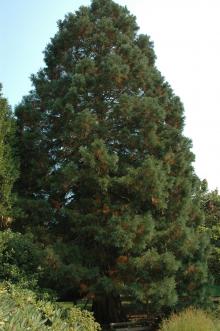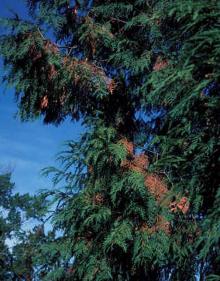Cause Evergreen plants, including conifers and broad-leaf types, naturally shed some old foliage each year. Abies and Picea tend to have long needle retention times while Pinus tends to have a shorter retention time. Stress factors, such as insufficient water, hot winds, construction damage or other root disturbance, poor planting procedures, or recent planting can promote flagging. Larger stem diameters were found to be related to lower needle retention in Douglas-fir.
Symptoms Brown foliage develops on the tree or shrub in mid to late summer and is very obvious by early fall. Affected foliage is growth formed in previous years. Foliage developed during the current year (at branch tips) remains green. Brown branchlets are called flags and are generally spread uniformly throughout the canopy. Affected foliage may begin to drop during hot, dry weather. Most of the dead foliage is blown or washed out of the plant by wind and rain in fall and winter. The plant typically resumes its healthy appearance by spring.
Cultural control
- Additional irrigation may be needed during summer drought.
- Avoid disturbing soil, and thus roots, near plantings.
References Maton, C., and Gartner, B.L. 2005. Do gymnosperm needles pull water through the xylem produced in the same year as the needle? American Journal of Botany 92:123-131.
Smith, L., Primack, R.B., Zipf, L., Pardo, S., Gallinat, A.S., and Panchen, Z.A. 2019. Leaf longevity in temperate evergreen species is related to phylogeny and leaf size. Oecologia 191:483-491.



